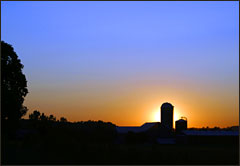 Is the sun setting on Midwest farming, or can it be saved by the dawn of a new model?In Coleridge’s “Rime of the Ancient Mariner,” a sailor contemplates the paradox of thirst amid a literal sea of water. “Water, water everywhere,” he famously laments, “nor any drop to drink.”
Is the sun setting on Midwest farming, or can it be saved by the dawn of a new model?In Coleridge’s “Rime of the Ancient Mariner,” a sailor contemplates the paradox of thirst amid a literal sea of water. “Water, water everywhere,” he famously laments, “nor any drop to drink.”
Rural Midwesterners can likely identify with that iconic seaman. Cornfields stretch to the horizon, but the harvest won’t end up on anyone’s plate — at least not directly. To provide useful calories for people, that corn is used to fatten animals on feedlots, or milled and processed into sweeteners, starches, and flours.
Like other U.S. citizens, Farm Belt residents increasingly turn to the supermarket, and thus the vast and far-flung industrial networks that supply it, for their sustenance. The region’s corn returns to its residents in the form of corn-syrup-sweetened Coca-Cola and corn-fed McDonald’s burgers.
If this odd arrangement actually generated wealth in the region, it might make some sense. But farming is such an economically disastrous endeavor in the Midwest that it’s a wonder anyone still does it.
Corn-based ethanol production has been hailed as a cure-all for the region’s farm economy, but as I showed last week, it’s certainly no panacea.
Another, potentially more sustainable, solution would be to rethink what a farm is for. Currently, a typical farm in the Midwest produces inputs for industrial production. What if, instead, farms focused on growing fresh food for their neighbors?
The Hand That Feeds You
At first glance, the idea is absurd. The rural Midwest doesn’t seem to have the population density to support a robust local-food economy. It’s one thing for specialty farms in New York state’s Hudson Valley, a short drive from the nation’s largest city, to “go local”; but it would never work in Iowa, where so many small towns have been all but abandoned and farms average 350 acres.
That’s the conventional thinking, anyway.
But independent Minnesota farm researcher Ken Meter challenges that wisdom. In the seminal 2001 paper “Finding Food in Farm Country” [PDF], written with John Rosales of the University of Minnesota, Meter argues persuasively that the dismal economics of farm-state agriculture could be improved by developing local markets.
Meter’s work shows that commodity farming, rather than building wealth, extracts money from rural communities. In a seven-county region of southeastern Minnesota in 1997, farmers brought in an impressive $866 million selling their wares. However, amazingly, they incurred $947 million in costs to do so — a loss of a cool $80 million. Federal subsidies covered just half of that loss; the rest had to be made up by non-farming activities.
Moreover, nearly half of the $947 million in incurred expenses left the area, as payments to distant suppliers of seeds, fertilizer, and pesticides, or to banks in the form of interest.
Meanwhile, though, the seven-county region’s 120,000 households were busily buying food and eating it. Meter reckons that southeastern Minnesotans were spending $500 million on food annually — and only $2 million of it on fare grown within the region. Yet if they could manage to buy just 20 percent of their food from nearby growers, that would amount to $100 million in additional sales for the region’s farms, more than wiping out their $80 million loss in 1997.
In case study after case study — not only in the Midwest, but also in farming-intensive areas in California, Arizona, and the Southeast — Meter teases out similar scenarios. Farming for distant commodity markets sucks resources out of communities, and residents of those communities spend heavily on food from outside. He doesn’t suggest that such regions turn insular and stop supplying or buying from outside markets; just that they consume a much higher portion of their food output locally.
Meter points to grassroots initiatives, such as southeast Minnesota’s cooperative grocery Root River Market, as examples of how to rebuild rural food networks.
Such efforts are important, and point to a way forward for revitalizing farm economies in the Midwest and in other farming regions. Yet they may not be enough to remedy 50 years of disinvestment in local-food infrastructure. In the Midwest, the built environment — grain elevators, freight networks — has been carefully rigged to accommodate mass production of a few inedible commodity crops.
In The Omnivore’s Dilemma, Michael Pollan asked the renegade Iowa farmer George Naylor why he kept growing commodity crops despite the ruinous economics. His reply is worth noting: “We’ve got a long-term investment in growing corn and soybeans; the elevator is the only buyer in town, and the elevator only pays me for corn and soybeans. The market is telling me to grow corn and soybeans, period.”
Rebuilding farm economies in the heartland might require public investment in new distribution and processing infrastructure. If that sounds like a crazy socialist experiment, consider that under the current Farm Bill, the federal government props up economically and environmentally suspect commodity agriculture to the tune of about $20 billion per year. And a recent study figures that the U.S. government doles out as much as $7.3 billion subsidizing production of biofuels, mainly corn-based ethanol — despite, at best, dubious public benefits.
These infusions of federal cash have done little to stanch economic hemorrhaging in the rural Midwest. As Meter’s work shows, providing incentives for farmers to produce food for their neighbors just might. And given the energy-intensive nature of industrial agriculture, such a policy might actually offset more fossil-fuel use than boosting corn ethanol production ever could.


